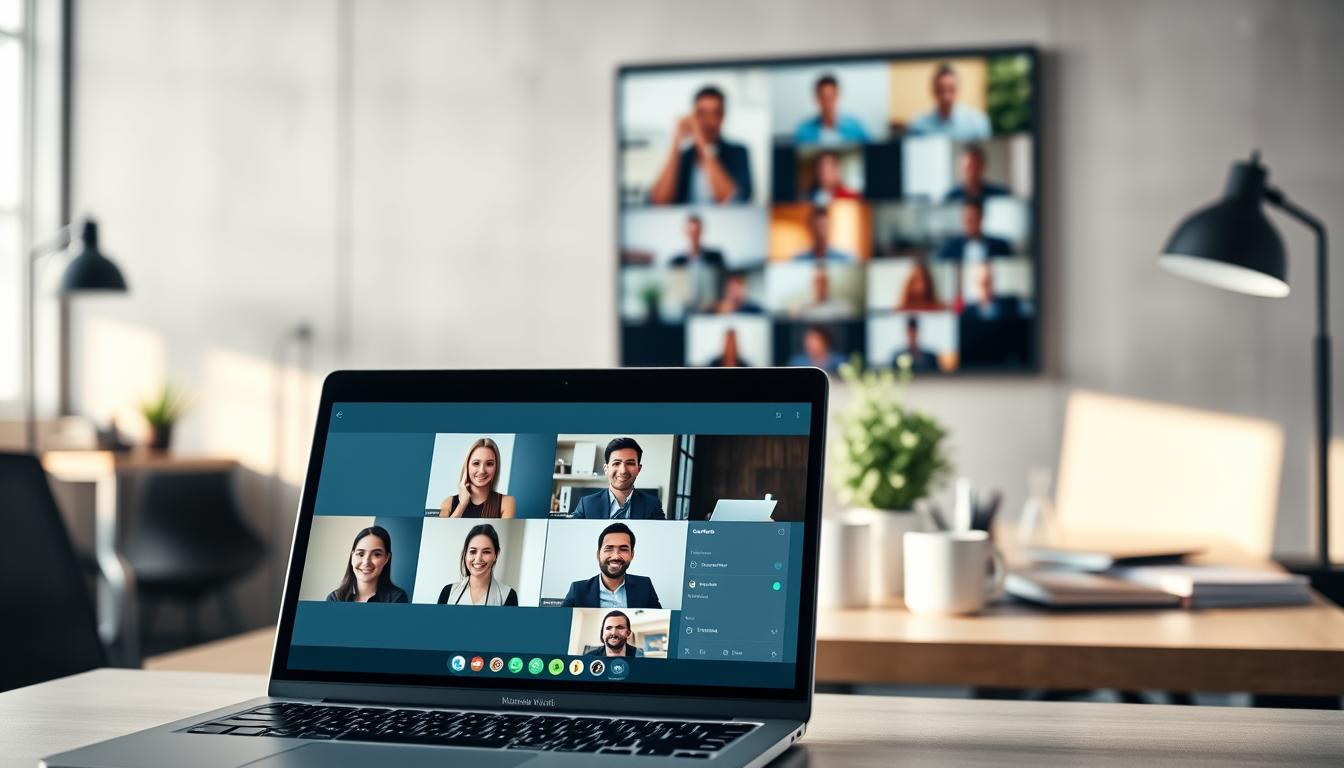In today’s fast-paced business world, effective meetings are key to a team’s success. We will share important tips to make your meetings more focused and result-driven. By using smart strategies and managing time well, teams can avoid distractions and make every meeting valuable. Let’s dive into ways to improve your meeting approach, making sure every session is clear, purposeful, and urgent.
Understanding the Importance of Productive Meetings
Productive meetings are key for good communication and teamwork. They help team members work better together, leading to better results. Making sure meetings have clear goals is crucial. Without them, meetings can become pointless.
Research shows only 11% of meetings are truly productive. This shows a big gap between what we expect and what really happens. Effective meetings boost team spirit, job happiness, and work output. Knowing this, teams should plan and hold meetings well.
Common Issues in Meetings
Meetings often face many challenges that slow down their productivity. One big problem is unproductive meetings that take a lot of time but don’t produce useful results. In these settings, it’s hard for everyone to be heard, especially with too many people talking without needing to be there.
Topics can easily stray, losing focus on the main goals and wasting time.
Studies show that a lot of professionals spend too much time in meetings that don’t achieve their goals. For example, in the UK, workers lose about 13 days a year in meetings that don’t help. This highlights the need for companies to fix these common problems to make meetings more effective.
To solve these issues, taking action is key. Making sure meetings have clear goals, inviting only those who need to attend, and keeping the conversation on track can help a lot. By doing these things, teams can make their meetings more productive and effective.
The Cost of Unproductive Meetings
Unproductive meetings are costing companies a lot, with losses up to $100 million a year. This huge loss comes from not having efficient meetings. It means companies are not just losing money, but also valuable time that employees could use better.
Employees often spend about four hours every week on meetings. However, they don’t get much out of this time. Shockingly, 39% of people say they’ve fallen asleep during a meeting. This shows how important it is to make meetings better.
It’s crucial for companies to look at their meeting practices and make them more effective. By making meetings more engaging and well-organized, teams can work better. This can lead to improved performance for the entire company.
Defining the Purpose of Your Meeting
It’s crucial to know why you’re having a meeting. A good meeting has a clear purpose, like making decisions, brainstorming, or discussing important topics with many people involved. Knowing the exact reason helps decide if a meeting is needed or if other ways like emails or quick talks work better.
Understanding the purpose helps figure out if a meeting is really important. A meeting should focus on a specific goal to be successful. By clearly stating the meeting’s purpose beforehand, everyone can come prepared. This leads to achieving more during the meeting.
Creating an Effective Meeting Agenda
Making a good meeting agenda helps keep meetings on point. A right agenda leads the meeting, guiding talks so people stay on topic. It includes clear discussion topics, goals, assigned roles, and time limits to make the meeting run smoothly. Every topic is ranked to highlight the most crucial points, making sure they get enough attention.
Essential Elements of an Agenda
An efficient agenda has key parts that make a meeting work well. Remember to add:
- Specific topics for discussion
- Clearly defined goals for each agenda item
- Assigned roles and responsibilities for participants
- Time limits for each segment to enhance time management
The Role of Time Management
Managing time well is key to keeping talks on point in meetings. Following a set agenda can make meetings shorter and more productive. When everyone knows how much time they have, it keeps them involved and ideas flowing. With good agendas and focus on time, groups become more efficient and goal-focused in their meetings.
Meeting Productivity Tips: Setting Clear Objectives
Setting clear meeting objectives is key for productive talks and results. These goals help everyone understand the meeting’s purpose and what they need to do. They should also match the company’s larger goals, showing how important they are.
To make meetings more focused, state the meeting’s aim briefly. This makes discussions more direct and helps people prepare better. Knowing the goals encourages everyone to join in and stay engaged.
Sharing these goals early is helpful. It lets everyone know their role and their part in reaching the meeting’s goals. This approach leads to better outcomes and smoother teamwork.
Choosing the Right Participants
It’s very important to pick the right people for meetings to make them more productive. By choosing carefully, organizers can keep the focus and avoid wasting time. It’s key to invite only those who will add real value, making sure they have a clear role or knowledge that’s important for the meeting’s topics.
Selective Inviting for Better Focus
Selecting fewer participants can make meetings more effective. Here are a few tips for inviting people thoughtfully:
- Find out who has important input or the power to make decisions.
- Think about if each person really needs to be there, based on what the meeting is trying to achieve.
- Invite people with different viewpoints but try to keep the group small.
The Role of Key Decision-Makers
Having decision-makers at meetings is crucial for getting things done. These key people help focus the discussion on finding solutions. It’s important to remember:
- Make sure those who can make decisions are there to tackle issues on the spot.
- Bring in leaders who can give deeper insights into the big picture planning.
- The goals of the meeting should match what the decision-makers can do.
Utilizing Technology for Enhanced Meeting Efficiency
Meeting technology is key for better virtual meetings. The right tools make processes smooth and keep discussions on track. They help in planning and running meetings more accurately.
Digital Tools for Scheduling and Note-taking
Using digital tools for scheduling and note-taking is very helpful. Tools like Google Calendar or Microsoft Outlook make it easy to avoid double-booking and keep everyone updated. Note apps like Evernote or OneNote can capture key points and to-dos, which you can share right after. These tools help teams be more organized and goal-oriented.
Asynchronous Communication Options
Asynchronous communication is now a big part of team collaboration. With tools like Loom or Slack, members can exchange updates and ideas at any time. This makes managing tasks easier, letting teams work smoothly even without meetings. It helps build a productive culture, overcoming time zones or busy schedules.
Engaging Participants Through Ground Rules
Setting up ground rules for meetings is key to a respectful and productive environment. These rules make sure everyone knows how to behave and participate. Leaders can increase engagement by cutting down on multitasking and limiting tech use.
Having specific times for questions and talks makes the agenda clear. This lets people add more effectively. Going over the rules often makes them stay important. This leads to better meetings over time.
When people know there’s a structure, they can talk more openly. The conversations become focused and respect everyone’s time.

Measuring Meeting Effectiveness
Meetings that work well are key for any group wanting to move forward. To see if a meeting went well, you look at many factors that help get things done. By using certain ways to check meetings, businesses can see what’s working and what’s not. This helps them get better and makes those attending more involved.
Tracking Time and Attendance Metrics
Managing time is super important when figuring out if a meeting was effective. Keeping an eye on time and who comes can show trends in how meetings run. Here are key things to look at:
- How long each meeting lasts compared to the planned agenda
- How many invited people actually show up
- How often meetings are cancelled or need to be moved
Looking at these points can tell if meetings are hitting their goals and if people think they are worth it.
Gathering Feedback from Attendees
It’s critical to know what people think to understand if your meetings are working. Asking for their views through surveys or talks after the meeting helps dig into its effects. You should consider:
- How happy people were with what the meeting achieved
- If people think the topics talked about were important
- How to make future meetings better, based on suggestions
By paying attention to these areas, groups can improve their meetings. This is done by using real thoughts from those who came. Doing this not only helps figure out if meetings are successful but also encourages always getting better.
Conclusion
We’ve talked about how to make meetings better for everyone in our summary on meeting productivity. We learned the importance of having clear goals, making good agendas, and using tech well. These steps help make meetings more useful and keep everyone interested and involved.
Our look back at effective meetings shows how important it is for every meeting to have a clear purpose and plan. This is key for any organization that wants to cut down on wasted time and create a better place to work.
By putting our tips into action, teams can find ways to make better use of their time and boost morale. When organizations focus on improving meetings, they pave the way for better teamwork and success at all levels.



